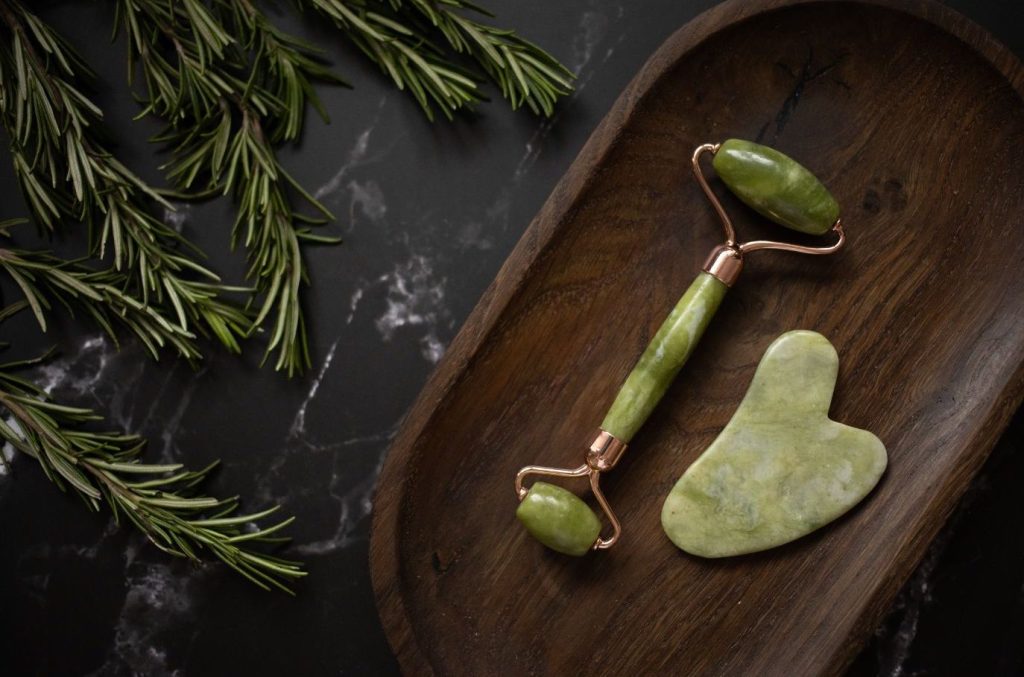How does gua sha facial massage support skin health?
Gua sha facial massage therapy is a 2000-year-old, but still widely-used, noninvasive healing technique in East Asia [1]. “Gua” refers to uni-directional, instrument-assisted scraping at specific acupuncture points and meridians on the face and body. “Sha” refers to the rash-like redness associated with the therapy, as blood is brought to the surface of the skin [1]. A rough translation for the phrase is “scraping away the pain”. On the face, the instrument used is usually a smooth-edged stone like honed jade or quartz. The “sha” or petechiae visible after a body treatment should not be visible on the face. The scraping motions will be much gentler than those used on the body, and your therapist will tailor their treatment to your specific needs and sensitivity level.
Because no “sha” appears in facial gua sha, the name itself is controversial in some communities. Some practitioners may be more likely to refer to this practice as facial massage or “facial tuina”. For our purposes, we will continue to refer to it as facial gua sha, as this is the popular terminology at present. You can perform facial gua sha on yourself, but it is best to start by working with an expert practitioner. They can guide you in the specific pressure, motions, and tools that are right for your skin.

How does gua sha facial massage support skin health?
Facial gua sha offers many potential benefits for both the mind and body generally. A few of which are associated with brighter, clearer, more youthful-looking skin.
Here are the top 5 most commonly cited benefits:
1. Detoxification
One of the intentions of gua sha is the movement of lymph. Lymph is the fluid element of the immune system. Its roles include bringing white blood cells to break down pathogens, and filtering toxins from the blood, so they can be excreted through sweat, breath, urine, and bowel movements [2]. Lymph nodes, the epicenters of this filtration process, are located all around the body. A few are found on the face and many are located under the chin, jaw, and down the sides of the neck.
When lymph nodes are massaged in a one-way motion, it can aid in loosening any toxic build-up in the nodes. Research indicates that the pressure from massage actually mechanically pushes the lymph through gaps between endothelial cells in the collecting lymph vessels [2]. Raising the temperature of the skin can also force more junctions between endothelial cells to open [2]. Both of these factors contribute to the drainage effect of gua sha massage on the lymph and detoxification.
2. Tension Relief
Many of us hold tension in our face and neck. The relaxing effect of gua sha as self-care may alone help release and relieve some of that stored stress.
Frown lines are called such for a reason. Anxiety, stress, and tension are expressed on the face and continual frowning can contribute to the appearance of permanent creases and wrinkles in the skin [3]. Relaxing facial muscles can prevent or fade some of these wrinkles. Gua sha is a practice that will help to relax your facial muscles [4]
3. Natural Tightening
Dubbed “the natural Botox”, gua sha may actually help firm the skin. Because of the high risk of adverse effects from Botox, many people are looking for natural alternatives for creating a lift and reducing the appearance of wrinkles.
Gua sha does this through the stimulation of blood flow. The stimulation of blood flow is thought to promote collagen formation and cellular repair for youthful skin elasticity [5]. The edges of different stone tools aid in activating facial muscles, for toning, sculpting, and lifting. Like a workout for your face, you have to commit to practicing gua sha every day if you expect to see visible results.
4. Dewey Texture
Due in part to that same circulatory stimulation, skin texture is thought to improve with gua sha practice. The improved oxygenation and delivery of nutrients through blood flow, and removal of toxins through lymph both contribute to visibly healthier skin.
Often, one of the most noticeable facial changes is reduced “puffiness” or inflammation. Likely, this effect is due to the delivery of natural anti-inflammatories through circulatory benefits and the removal of excess fluid through lymph movement [6].
Also, gua sha is always conducted with a face serum, moisturizer, or oil. The movement of the tool may aid in absorption, leaving skin more hydrated than a by-hand application of the same products.
5. Clear Breakouts/Rosacea
While it is not recommended to practice gua sha on open sores or active breakouts, the practice can have a long-term effect of preventing blemishes or clearing skin. If you have acne or rosacea at present, focusing gua sha motions on the lymph nodes of the neck can help to clear the toxins from within. Generally, the advice for facial gua sha is to work the areas beneath where the problem lies, not the problem area directly [7].
When first beginning a gua sha routine, the pathogens and toxins trapped in the skin and pores will be brought to the surface. You may notice more blemishes in the short term. With improved circulation and lymph drainage, blemishes should soon clear, leaving skin brighter and dewier.
Parting thoughts
While there is a great deal of science to back up the practice of gua sha on the body, facial gua sha massage has fewer published, peer-reviewed studies to back it up. The most supportive evidence for facial gua sha seems to be testimonials, anecdotes, and before/after photos.
On the other hand, more invasive techniques for improving the appearance of the skin, such as Botox, come with a great deal of risk. Rather than putting full faith in gua sha to radically change our appearance, it may be better to consider this practice a relaxing, self-care routine with little (if any) risk.
Best case scenario: the rumours are true and you come away with a clearer, tighter, younger-looking skin. Worst case scenario: you spend a few extra minutes each day caring for yourself, relaxing. And, you will still reap the benefits of your favourite skin care products.
From where we stand, that sounds like a win-win.
- Wang, Yu-wei, et al. “Gua sha therapy for chronic low back pain: A protocol for systematic review.” Medicine 99.40 (2020).
- Cassar, Mario-Paul. “Massage for detoxification.” (2006).
- de Almeida, Ada Regina Trindade, E. R. da Costa Marques, and B. V. Kadunc. “Glabellar wrinkles: a pilot study of contraction patterns.” Surg Cosmet Dermatol 2.1 (2010): 23-28.
- Bernardo, Serina. “Gua Sha (aka Jade Rollers): Does Science Back its Claims?.”
- Lewington, Prue. “Women Are Giving Up Botox for Facial Massage” Harper’s Bazaar. MAY 23, 2019. https://www.harpersbazaar.com/beauty/skin-care/a27229712/gua-sha-benefits-botox-alternative/
- Nielsen A. Gua Sha, A Traditional Technique for Modern Practice, 2nd Edition. Edinburgh: Churchill Livingstone Elsevier, 2013.
- Kokko, Katja. “Gua sha for acne and rosacea”. Beauty. Jan 10, 2019. https://katjakokko.com/en/gua-sha-for-acne-and-rosacea/
Share:
Related Posts

Goodbye Pie Chart, Hello Phase 1 Sliders
Written by Allison Smith, ND | 2025 As we usher in a new era of DUTCH testing which leaves behind the concept of the three-way

Introducing the DUTCH Dozen
Written by Kelly Ruef, ND | 2025 Hormone testing can be complex, which is why Precision Analytical developed the DUTCH Dozen, an interpretive framework that

DUTCH Report Enhancements
Written by Hilary Miller, ND | 2025 Precision Analytical have released the newest version of the DUTCH Test. This is the report’s most significant update

Gallbladder Health 101: What It Does and How to Keep It Working Well
Written by Ashley Palmer & Pooja Mahtani | 2025 The gallbladder may not get much attention compared to the gut, but it plays a central

Can You Bring Vitamins on a Plane? How To Travel with Supplements
Written by Austin Ruff | 2024 Are you traveling for a work conference, an athletic competition, or a weekend getaway? Just because you’re leaving home

